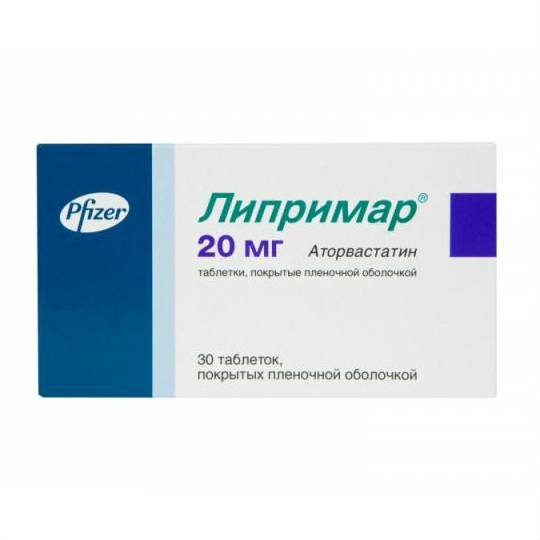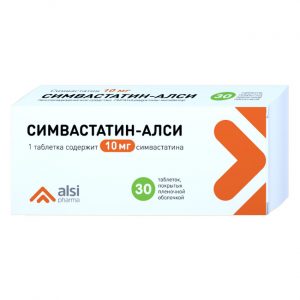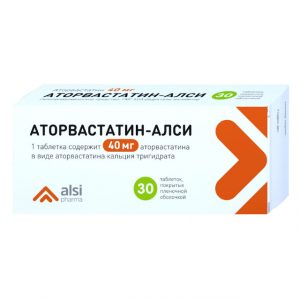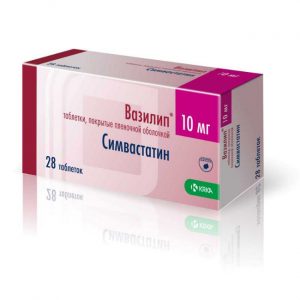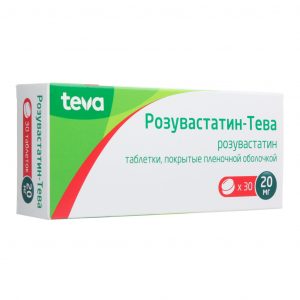Description
Pharmacological action
LIPRIMAR – a lipid-lowering drug from the group of statins. According to the principle of competitive antagonism, the statin molecule binds to that part of the coenzyme A receptor where HMG-CoA reductase is attached. Another part of the statin molecule inhibits the conversion of hydroxymethylglutarate to mevalonate, an intermediate in the synthesis of cholesterol molecules. Inhibition of the activity of HMG-CoA reductase leads to a series of sequential reactions, resulting in a decrease in the intracellular cholesterol content and a compensatory increase in the activity of LDL receptors and, accordingly, accelerated catabolism of LDL cholesterol (Xc).
The hypolipidemic effect of statins is associated with a decrease in total cholesterol due to LDL cholesterol. The decrease in LDL is dose-dependent and is not linear, but exponential. The inhibitory effect of Atorvastatin ® against HMG-CoA reductase is approximately 70% determined by the activity of its circulating metabolites.
Statins do not affect the activity of lipoprotein and hepatatic lipases, do not significantly affect the synthesis and catabolism of free fatty acids, therefore, their effect on the level of TG is secondary and mediated through their main effects in lowering LDL-C. A moderate decrease in the level of TG during treatment with statins is apparently associated with the expression of remnant (apo E) receptors on the surface of hepatocytes involved in catabolism of STDs, which comprise about 30% TG. Compared to other statins (with the exception of rosuvastatin), atorvastatin ® causes a more pronounced decrease in TG levels.
In addition to lipid-lowering effects, statins have a positive effect on endothelial dysfunction (preclinical sign of early atherosclerosis), on the vascular wall, atheroma state, improve blood rheological properties, have antioxidant, antiproliferative properties.
Atorvastatin ® lowers cholesterol in patients with homozygous familial hypercholesterolemia, which is usually not amenable to hypolipidemic therapy.
Indications of
in combination with a diet to reduce elevated levels of total cholesterol, HDL-C, apolipoprotein B and triglycerides and increase HDL-C in patients with primary hypercholesterolemia (heterozygous familial and non-familial hypercholemia of mixed choleraemia II) classification), in which diet therapy does not give an adequate effect of
in combination with a diet for the treatment of patients with elevated serum triglycerides (type IV according to the classification of Fredrickson) and patients with sbetalipoproteinemiey (type III Fredrickson classification) in which diet therapy does not provide an adequate effect of
to reduce total cholesterol and LDL-C in patients with homozygous familial hypercholesterolemia with insufficient efficacy of diet therapy and other non-pharmacological treatments for
to reduce the risk of lethal outcomes of IHD and the risk of myocardial infarction, angina pectoris and stroke reduce the need for revascularization procedures in patients with cardiovascular diseases and / or dyslipidemia, as well as if these diseases were not detected us, but there are at least three risk factors for coronary heart disease, such as age over 55, smoking, hypertension, low blood concentrations of LDL-HDL plasma cases of coronary heart disease early development relatives.
Contraindications
active liver disease or increased serum activity of transaminases (more than 3 times the upper limit of normal) of unclear genesis
women of reproductive age who do not use adequate methods of contraception
pregnancy
lactation (breastfeeding component) the drug
in children and adolescents under the age of 18 years, the effectiveness and safety of liprimar have not been established.
Caution should be used in patients who abuse alcohol and / or have a liver disease (history).
Use during pregnancy and lactation
Liprimar ® is contraindicated in pregnancy.
Women of reproductive age should use adequate contraceptive methods during treatment. Liprimar ® can be prescribed to women of reproductive age only if the probability of pregnancy is very low and the patient is informed about the possible risk of treatment for the fetus.
Liprimar ® is contraindicated during lactation. It is not known whether atorvastatin is excreted in breast milk. If it is necessary to prescribe the drug during lactation, breastfeeding should be stopped to avoid the risk of adverse events in infants.
Composition
1 tablet contains:
Active ingredient: atorvastatin (in the form of calcium salt) 20 mg
Excipients: calcium carbonate, microcrystalline cellulose, lactose monohydrate, sodium carboxymethyl cellulose, polysorbate 80, hydroxypropyl cellulose, magnesium stearate, Opadry White YS-1-7040, simethicone emulsion, powder wax.
Dosage and administration of
Before starting treatment with Liprimar, you should try to control hypercholesterolemia with diet, exercise and weight loss in obese patients, as well as treatment of the underlying disease.
When prescribing the drug, the patient should recommend a standard lipid-lowering diet, which he must observe during treatment.
The drug can be taken at any time of the day, regardless of food intake. The dose of the drug (from 10 to 80 mg 1 time / day) is selected taking into account the initial levels of LDL-C, the purpose of therapy and the individual effect. At the beginning of treatment and / or during an increase in the dose of Liprimar, it is necessary to monitor plasma lipid levels every 2-4 weeks and adjust the dose accordingly.
With primary hypercholesterolemia and combined (mixed) hyperlipidemia in most patients, the necessary effect can be achieved with Liprimar at a dose of 10 mg 1 time / day. The therapeutic effect is manifested within 2 weeks and usually reaches a maximum within 4 weeks. With prolonged treatment, the effect persists.
Patients with homozygous familial hypercholesterolemia are prescribed a dose of 80 mg 1 time / day (in most cases, therapy led to a decrease in the level of LDL-C by 18-45%.
Impaired renal function does not affect the level of atorvastatin in plasma or the degree of decrease in the level of XC LDL-C when using Liprimar, therefore, dose changes are not required.
When using the drug in elderly patients, differences in safety, efficacy or achievement of the goals of lipid-lowering therapy compared to the general population
Side effects of
From the side of the central nervous system: insomnia, headache, asthenic syndrome.
From the digestive tract: nausea, diarrhea, abdominal pain, dyspepsia, constipation, flatulence.
From the musculoskeletal system and connective tissue: myalgia.
Less frequent adverse reactions ( 1%)
From the side of the central nervous system and peripheral nervous system: malaise, dizziness, amnesia, paresthesia, peripheral neuropathy, hypesthesia.
From the digestive tract: vomiting, anorexia, hepatitis, pancreatitis, cholestatic jaundice.
From the musculoskeletal system and connective tissue: back pain, muscle cramps, myositis, myopathy, arthralgia, rhabdomyolysis.
Allergic reactions: urticaria, pruritus, rash, anaphylactic reactions, bullous rash, polymorphic exudative erythema (including Stevens-Johnson syndrome), toxic epidermal necrolysis (Lyell’s syndrome).
From the side of metabolism: hypoglycemia, hyperglycemia, increased serum creatine phosphokinase (CPK).
From the hemopoietic organs: thrombocytopenia.
Other: impotence, peripheral edema, weight gain, chest pain, secondary renal failure, alopecia, tinnitus, fatigue.
Drug Interaction
The risk of myopathy during treatment with HMG-CoA reductase inhibitors is increased with the simultaneous use of cyclosporine, fibrates, erythromycin, clarithromycin, antifungal agents – azole derivatives, and nicotinobosin.
Cytochrome CYP3A4 isoenzyme inhibitors. Because atorvastatin is metabolized by the cytochrome CYP3A4 isoenzyme, co-administration of atorvastatin with CYP3A4 cytochrome isoenzyme inhibitors may lead to increased plasma concentrations of atorvastatin. The degree of interaction and the potentiation effect is determined by the variability of the effect on the cytochrome CYP3A4 isoenzyme.
OATP1B1 transport protein inhibitors. Atorvastatin and its metabolites are substrates of the transport protein OATP1B1. OATP1B1 inhibitors (eg cyclosporine) may increase the bioavailability of atorvastatin. Thus, the combined use of atorvastatin at a dose of 10 mg and cyclosporine at a dose of 5.2 mg / kg / day leads to an increase in the concentration of atorvastatin in the blood plasma by 7.7 times (see “Method of administration and dose”).
Erythromycin / clarithromycin. With concomitant use of atorvastatin and erythromycin (500 mg 4 times a day) or clarithromycin (500 mg 2 times a day), which inhibit the cytochrome isoenzymeCYP3A4, an increase in the concentration of atorvastatin in the blood plasma was observed (see “Special Instructions”).
Protease inhibitors. The concomitant use of atorvastatin with protease inhibitors known as CYP3A4 cytochrome isoenzyme inhibitors is accompanied by an increase in the concentration of atorvastatin in blood plasma (when concomitantly used with erythromycin Cmax, atorvastatin increases by 40%).
Diltiazem. Co-administration of atorvastatin at a dose of 40 mg with diltiazem at a dose of 240 mg leads to an increase in the concentration of atorvastatin in the blood plasma.
Cimetidine. No clinically relevant interaction of atorvastatin with cimetidine was found.
Itraconazole. Concomitant administration of atorvastatin at doses of 20 to 40 mg and itraconazole at a dose of 200 mg increased the atorvastatin AUC.
Grapefruit juice. Because grapefruit juice contains one or more components that inhibit the cytochrome CYP3A4 isoenzyme, its excessive consumption (more than 1.2 liters per day) may cause an increase in the concentration of atorvastatin in the blood plasma.
Cytochrome CYP3A4 isoenzyme inducers. Co-administration of atorvastatin with CYP3A4 cytochrome isoenzyme inducers (eg, efavirenz or rifampicin) may result in a decrease in the plasma concentration of atorvastatin. Due to the dual mechanism of interaction with rifampicin (CYP3A4 cytochrome isoenzyme inducer and hepatocyte transport protein inhibitor OATP1B1), atorvastatin and rifampicin are recommended simultaneously, as delayed administration of atorvastatin after taking rifampicin results in a significant decrease in the concentration of atorvastatin in the blood plasma.
Antacids. Concomitant intake of magnesium hydroxide and aluminum hydroxide suspension reduced the concentration of atorvastatin in the blood plasma by about 35%, but the degree of reduction of the Xc-LDL content did not change.
Phenazon. Atorvastatin does not affect the pharmacokinetics of phenazone, so interaction with other drugs metabolised by the same cytochrome isoenzymes is not expected.
Colestipol. When co-administered with colestipol, the concentration of atorvastatin in the blood plasma decreased by about 25%, but the hypolipidemic effect of the combination of atorvastatin and colestipol was superior to that of each drug separately.
Digoxin. Repeated administration of digoxin and atorvastatin at a dose of 10 mg Css digoxin in blood plasma did not change. However, when using digoxin in combination with atorvastatin at a dose of 80 mg / day, the concentration of digoxin increased by about 20%. Patients receiving digoxin in combination with atorvastatin require appropriate follow-up.
Azithromycin. Atorvastatin 10 mg once daily and azithromycin 500 mg once daily did not change the concentration of atorvastatin in the blood plasma.
Oral contraceptives. With concomitant use of atorvastatin and oral contraceptive containing norethisterone and ethinylestradiol, a significant increase of norethisterone and ethinylestradiol AUC was observed by about 30 and 20%, respectively. This effect should be considered when choosing an oral contraceptive for a woman taking atorvastatin.
Terfenadine. No clinically relevant changes in the pharmacokinetics of terfenadine were observed with atorvastatin and terfenadine.
Warfarin. No evidence of a clinically relevant interaction of atorvastatin with warfarin was found.
Amlodipine. With atorvastatin 80 mg and amlodipine 10 mg, the pharmacokinetics of atorvastatin did not change at steady state.
Another concomitant therapy. In clinical trials, atorvastatin was used in combination with antihypertensive agents and estrogens in the context of replacement therapy for signs of clinically significant undesirable interaction. No interaction studies were observed with other specific drugs.
overdose
Treatment: There is no specific antidote for the treatment of overdose with Liprimar ®.
In case of overdose, symptomatic treatment should be performed as needed. Because the drug actively binds to plasma proteins, hemodialysis is ineffective.
Storage conditions
Store at a temperature not exceeding 25 ° C, out of the reach of children.
Shelf suitability
3 Year
Other substance
Atorvastatin
dosage form
dosage form
tablets
Pfizer USA
